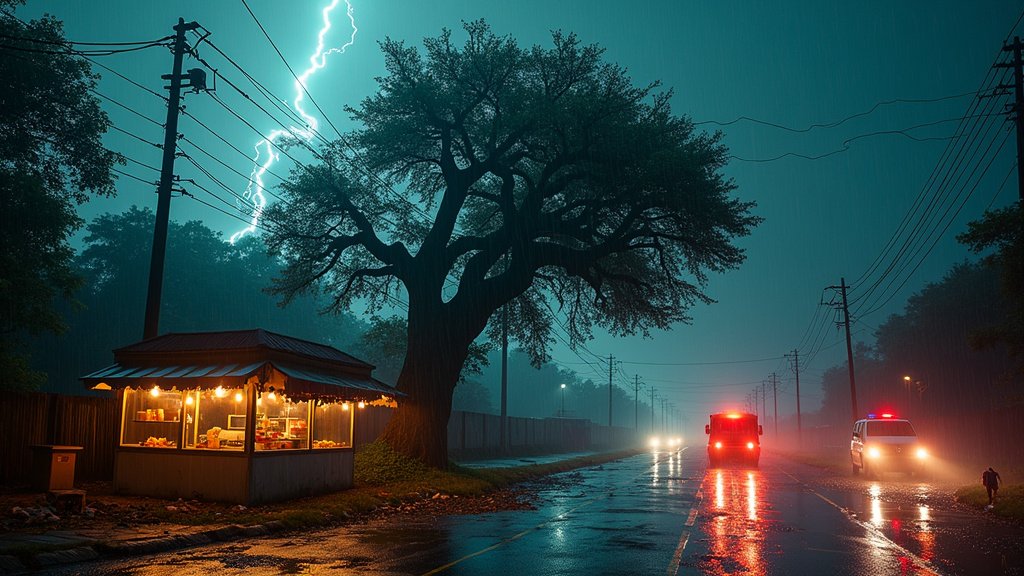A devastating incident in the national capital on Sunday, June 15, 2025, resulted in the tragic deaths of two men due to electrocution. The victims, identified as Ravinder, 30, and Bharat, 25, were killed in south-west Delhi’s R.K. Puram Sector 1 after a tree, uprooted by torrential rain and powerful winds, collapsed onto an overhead power line. The severity of the storm and the resulting power outage have highlighted the vulnerability of infrastructure during extreme weather events.
Fatal Night in R.K. Puram
The tragedy unfolded late Sunday night in R.K. Puram, a residential area known for its mix of housing and commercial establishments. Witnesses reported that the storm, characterized by intense rainfall and sustained high winds, caused widespread damage, including the uprooting of several trees. One such tree, its roots weakened by the saturated ground and the force of the wind, succumbed to the elements and toppled onto a high-voltage power line. The falling tree severed the power line, causing it to come into contact with the ground.
Ravinder and Bharat, both employed at a roadside food kiosk, were sleeping outside their place of work when the incident occurred. The kiosk, a common sight in the area, provided a source of livelihood for the two men, who were natives of Madhubani, Bihar. Their proximity to the fallen power line proved fatal as the electricity coursed through the tree and into the surrounding area, leading to their immediate electrocution. The impact of the tragedy resonated throughout the local community and brought into sharp focus the precarious living conditions of many workers in the city.
Stray Dog Also Killed
Adding to the sorrow of the event, a stray dog also perished due to the electric shock. This grim detail underscores the dangers of such incidents to all living creatures in the vicinity. The presence of the dog highlights the indiscriminate nature of the danger posed by fallen power lines, emphasizing the urgent need for safety measures during and after severe weather conditions.
Immediate Response and Investigation
Following the incident, authorities were quick to respond, dispatching emergency services to the scene. The area was cordoned off to secure the safety of the public and to allow for an investigation into the cause of the tragedy. Power supply to the affected area was immediately cut off to prevent further casualties. Police and electricity board officials began a thorough assessment of the damage and an investigation to determine the exact sequence of events that led to the electrocution. The investigation is expected to examine the maintenance of the power lines and the response time of the authorities after the storm.
The Broader Implications of Infrastructure and Safety
The incident in R.K. Puram raises critical questions about the preparedness of Delhi’s infrastructure to withstand the increasing frequency and intensity of extreme weather events. The city, like many urban centers, has experienced a surge in the number of severe storms and heavy rainfall in recent years, putting a strain on existing infrastructure. The collapse of the tree and the subsequent electrocution highlighted the importance of regular tree trimming around power lines, reinforcing the need for comprehensive city planning and infrastructure maintenance to safeguard the lives of residents. Further investigations will likely center on the adequacy of existing safety protocols and the need for improved warning systems and emergency response mechanisms.
The deaths of Ravinder and Bharat serve as a stark reminder of the human cost of infrastructure failures and the devastating impact of extreme weather conditions. Their loss has cast a shadow over the community and prompted calls for enhanced safety measures to prevent similar tragedies in the future. The authorities have initiated a thorough probe, promising to implement necessary corrective actions to mitigate the risks associated with overhead power lines, particularly during periods of inclement weather. The long-term implications of this event include the need for improved urban planning, enhanced infrastructure resilience, and the protection of vulnerable communities from the dangers of extreme weather.

